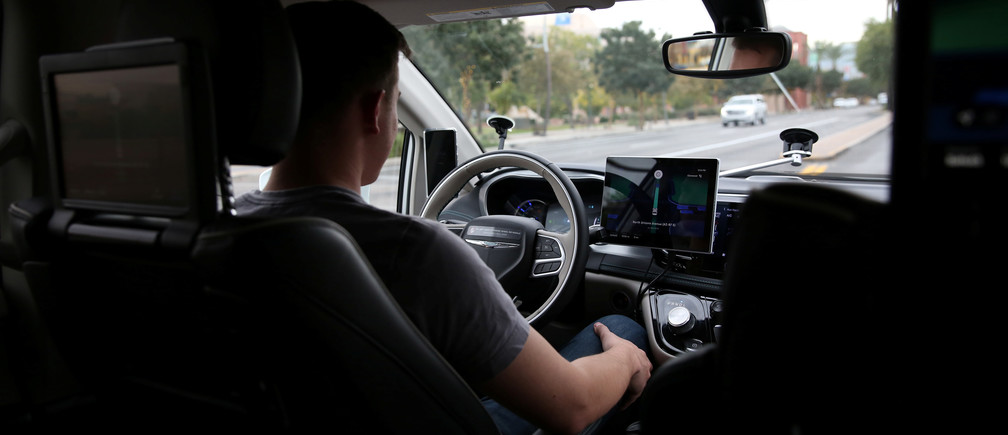How should cities prepare for self-driving cars? Here's a roadmap

The autonomous vehicle age has already begun, and cities have lots of work to do to prepare for the changes it will bring Image: REUTERS/Caitlin OHara
If forecasts hold true, autonomous vehicles (AVs) operating as taxi fleets without human safety drivers could be in widespread use in cities around the world by 2030. The current commercial operation of robo-taxis for hire is, for now, very limited, and does not yet operate without human supervision. A leading example of one such service is Waymo One, which has been operating in Phoenix, Arizona since December 2018. Waymo One operates in a limited area, has a safety driver ready to intervene if needed, and charges rates in a similar way to other ride sharing companies for the service.
With the influx of this technology, some cities are being called upon to address residents’ concerns about autonomous vehicles operating on their city’s streets. Cities such as London, Shanghai, Pittsburgh and San Francisco all have test fleets of autonomous light passenger vehicles in operation. As this technology advances, municipal government officials need to consider what they can and should do to prepare their citizens for the future as well as develop cooperative relationships with the companies testing and potentially offering services to citizens and visitors. The development and adoption of an AV-mode specific policy framework is a logical place to start.
We have identified six phases to develop an AV framework for cities:
1. A place to start – citizens’ opinions
Recent polls show Americans are highly sceptical of AVs. AAA’s most recent survey from March 2019 found 71% of respondents felt afraid to ride in an autonomous vehicle. Additionally, a Reuters/Ipsos poll from April 2019 shows that half of US adults think AVs are more dangerous than human-driven vehicles. Meanwhile, in other countries such as India, China and South Korea, citizens are more open to AVs. While opinions may be split on the technology, many citizens expect their governments to take the lead and address their concerns around safety and transportation.
To begin developing a framework around the operation of AVs on their streets, city officials should first speak with residents and obtain their points of view. A range of representative bodies should be consulted through this process to ensure that all stakeholder views are captured, such as neighbourhood councils, advocacy groups for pedestrian safety, cyclist groups and advocates for disabled persons. Through this community engagement, cities can begin to identify the key areas most likely to be impacted by AVs and develop strategies on how to prevent, address or anticipate future concerns. Additionally, involving citizens throughout the process will help them become a part of the technology advancement, rather than feeling this is something that has been thrust upon them.
Before drafting specific autonomous vehicle regulations, policies or principles, talk to city officials in key departments including public works, enforcement, public health and tax collection. Cast a wide net to gather a holistic review of the different departments that play a role within the existing transportation system. A well-established dialogue between the different departments will provide insight into how those departments perceive the potential impacts of AV technologies, as well as how they are preparing to address them. A cross-department dialogue is an opportunity to educate internal officials on AVs, establish a common narrative and agree on a clear pathway forward that suits all these stakeholders.
3. Examine potential impacts on existing mobility principles
Most cities have mobility principles that have been developed, adopted and widely circulated. San Francisco has 10 guiding principles for emerging mobility services and technologies that include a Vision Zero for reducing conflicts and ensuring public safety, encouraging high-occupancy modes of transit and equitable access, to name a few. Others, such as Pittsburgh, have signed on to ‘Shared Mobility Principles for Livable Cities’ as put forth by Robin Chase, founder of the New Urban Mobility Alliance (NUMO).
Some cities have gone further by initiating public-private partnerships to fund collaborative research into the future of mobility - such as Drive Sweden, which funds several tests and projects around many aspects of transportation, including autonomous shuttle bus services.
With these mobility principles in place, consider how AVs could impact each dimension of the vision as defined. The cross-functional learnings from city departments can be fed into these principles to ensure relevance across the municipality’s operations. This can be the basis of a first draft and provide a foundation for refinement from other cities and commercial entities.

Develop a list of cities with similar characteristics - such as population, density and geography - and identify those being considered for AV testing and development. Many municipalities are facing the launch of automated technologies, and many are taking different approaches to suit their individual needs. Speak with the people in these cities who are also dealing with AV technology deployments and testing. Learn their unique points of view, how they addressed a similar situation, what they have learned, what they would do differently, what their goals are, how they are communicating internally and externally, what systems they are developing and how they manage uncertainty. Developing a list of five common questions will help guide these conversations to ensure robust learnings can be shared.
Hard facts and data are hard to come by with emerging technologies such as AVs. It is powerful to learn from others who are grappling with similar issues or are further along in the planning process; city leaders value lessons from influential peers. Moreover, this will allow cities to create a global network through which to share knowledge in the future.
Ideally, cities have an established process for businesses to collaborate and partner with city departments. In the case of AVs, the industry is nascent and the dominant business model has not yet emerged, and questions remain over how to demonstrate the technology is safe. It is imperative that governments form a positive, open relationship with AV and mobility providers to create trust that will ultimately ensure safe deployment and management of automated vehicles.
There are many challenges in establishing such a dialogue, but it is not impossible. Hold education sessions with companies to share the logic behind mobility principles, citizens’ perspectives, mobility strategies and examples of the use of data to inform policy and enforcement.
Follow education sessions with listening sessions and interviews with individual companies to learn about their plans, challenges, goals and ideals. These points can inform policies and recommendations.
As this technology continues to evolve, and consumers’ lifestyles change as a result, policy change will be required. Not every policy, procedure and regulation will be universally embraced, nor will they all be correct right out of the gate. This is especially true for policies relating to emerging technologies with broad impact potential, such as AVs. Policies and procedures will need to evolve along with the technology and business models.
Hence, policy instruments which are agile by design, and which are supported by mechanisms to facilitate necessary change, are key. Ideally, data can be leveraged from the vehicles in use to allow regulators to make informed decisions and changes to policy initiatives. Linking recommendations to data-based metrics and setting up transparent ways to collect data, analyze and share results is vital.
During the process of working with citizens, advocacy groups, internal stakeholders and business communities, a trusted network can evolve to facilitate learning and update policies. Establishing regular outreach and a way for citizens and businesses to engage is not only valuable, but critical to ensuring technology governance remains relevant and appropriate.
Don't miss any update on this topic
Create a free account and access your personalized content collection with our latest publications and analyses.
License and Republishing
World Economic Forum articles may be republished in accordance with the Creative Commons Attribution-NonCommercial-NoDerivatives 4.0 International Public License, and in accordance with our Terms of Use.
The views expressed in this article are those of the author alone and not the World Economic Forum.
Stay up to date:
The Digital Economy
Forum Stories newsletter
Bringing you weekly curated insights and analysis on the global issues that matter.
More on Urban TransformationSee all
Luis Antonio Ramirez Garcia
August 11, 2025






